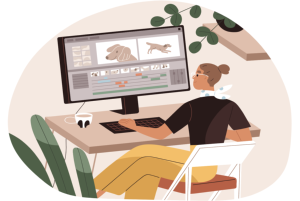
We use videos in so many ways in the ATE community; as part of classroom and lab instruction, for recruiting students, and as part of our outreach efforts to various stakeholders. And as we all use Zoom and other online platforms for meetings and conferences, we often record those events, creating more recorded video content. So how do we ensure that everyone can utilize this great content? By considering accessibility from the beginning, which is what this helpful tip sheet from the National Center for Accessible Media (NCAM) and AccessATE is all about!
Tip Sheet: Creating Accessible Videos
The tip sheet covers a number of different categories that relate to making video accessible. For those who are deaf or hard of hearing, captioning is critical, and it’s also very useful for many users for whom English is not their first language. For blind users, audio descriptions can be critical – particularly when you think about portions of a video set in STEM or lab settings where people are demoing or doing technical work.
Sometimes it’s easier to see something in action rather than read about it. A quick and effective example of the impact of captioning is to watch the preview for the movie “Frozen” with captioning and no description and then watch the more accessible version that includes both. Or, this video highlighting the need for inclusive STEM education from the nonprofit tech company Benetech provides a great example of the use of both audio description and captioning.
Additional Resources
Beyond the resources listed on the tip sheet, the following resources might also prove helpful as you explore the process of making accessible videos as part of your ATE-funded work:
- YouDescribe is a service developed by the Smith-Kettlewell Video Description and Development Center that allows you to add audio description to YouTube videos yourself. Simply enter the URL of the YouTube video to which you want to add audio description, select “Create/Edit Descriptions”, and use the “Play/Pause” and “Record” buttons to pause when you want to add description. YouDescribe is accessible and simple to use, but it does not allow for the result to play your audio description and the video you’ve described to play simultaneously, i.e., the video will pause for your description. Beyond using a service like this, you can record a separate sound file of a narrator describing all the visual information that is not covered by any existing narration or dialogue, then incorporate it into the video. Note that whatever option you choose, you will have to be strategic and concise while still being descriptive. The American Council of the Blind's guidelines for good audio description provide tips for audio describers, and “Turning Sights in Sounds” from Equal Entry includes rich examples of quality audio description.
- If you’d rather caption your videos yourself, Amara and Subtitle Horse are great options. Both services have free and paid services, and are browser-based, so you can work on your captioned projects anywhere you have an internet connection. Amara has especially robust translation service, and Subtitle Horse has a version optimized for mobile devices. The University of Washington has handy instructions on Adding Captions to YouTube Videos.
- Center for Inclusive Design and Innovation – The Center for Inclusive Design and Innovation, or CIDI, is part of Georgia Tech’s College of Design. CIDI provides a variety of captioning and audio description services that’s focused on the end-user, among other valuable accessibility resources.
- 3PlayMedia – Used by thousands of institutions and organizations, including the Perkins School for the Blind, the Computer History Museum, This American Life, and the IRS, 3PlayMedia provides closed captions, audio description, and transcription, all of which are essential to providing accessible video content. 3PlayMedia is a paid service, with a variety of plans that are made to work for a variety of needs. Please note that 3PlayMedia’s audio description services utilize synthesized speech.
By making your video content more accessible, you broaden your reach and improve the experience for more users. Creating accessible videos by including captions, audio description, or both, can seem daunting or like a lot of extra work, but there are many resources and options available to make the process smooth and simple.




 See More Feature Articles
See More Feature Articles